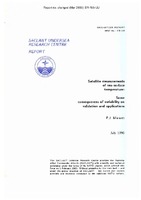| dc.description.abstract | Sea-surface temperature (SST) measurements from both spaceborne and in situ sensors are analysed to determine likely temperature differences that can arise between two measurements separated in space and time. This has implications both for satellite data validation, where an in situ measurement is compared with a remotely-sensed one, and for the use of SST measurements in numerical upper-ocean models, where an SST value is ascribed to, or compared with one from a nearby grid-point at the closest time-step. It is shown that spatial separations of 10 km and time intervals of 2 h can introduce rms differences of 0.2 K into the error budget of a satellite validation data set, which is an upper limit for the validation of current infrared radiometers. The length and time scales at which the autocorrelation functions decay to 0.5 are used as a criterion for the meaningful use of SST data with ocean models, and these are found to be 10-20 km and 6 h. This time constraint is not very severe, but the spatial constraint poses a significant sampling problem. On these length scales there appears to be no spatial anisotropy with respect to the dominant surface current flow direction, but there is some slight evidence that length scales are somewhat longer in daytime during the summer. | |
